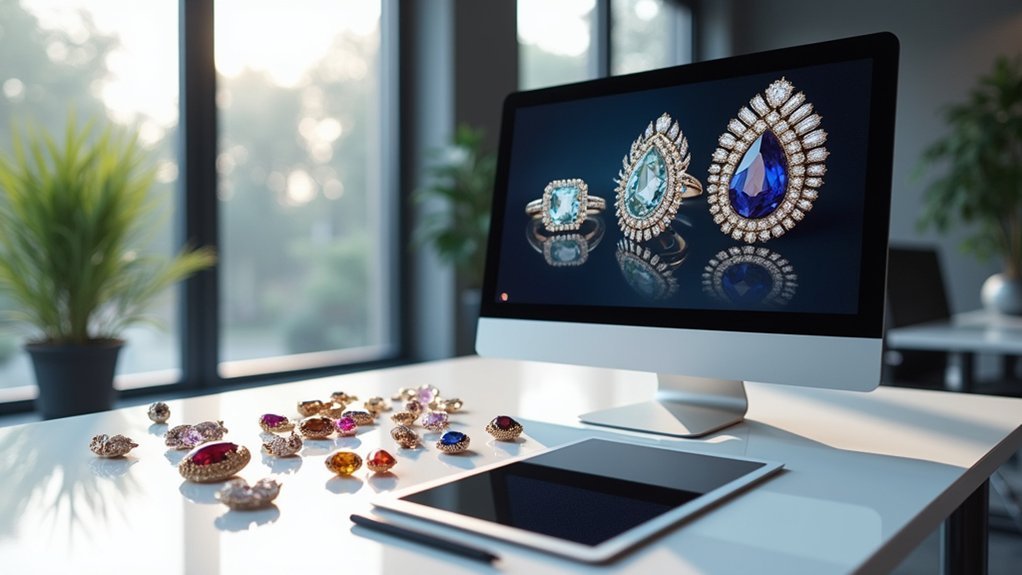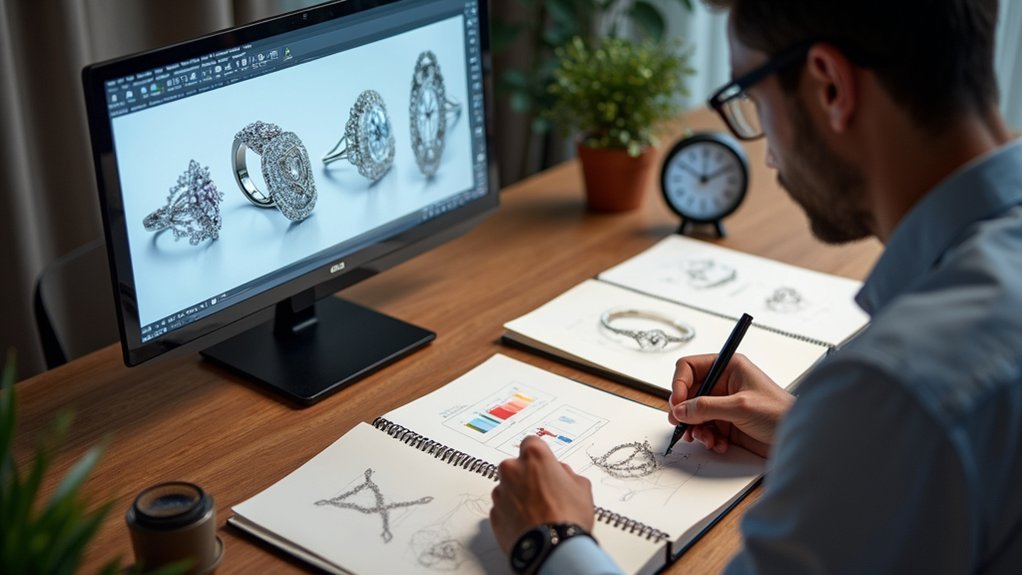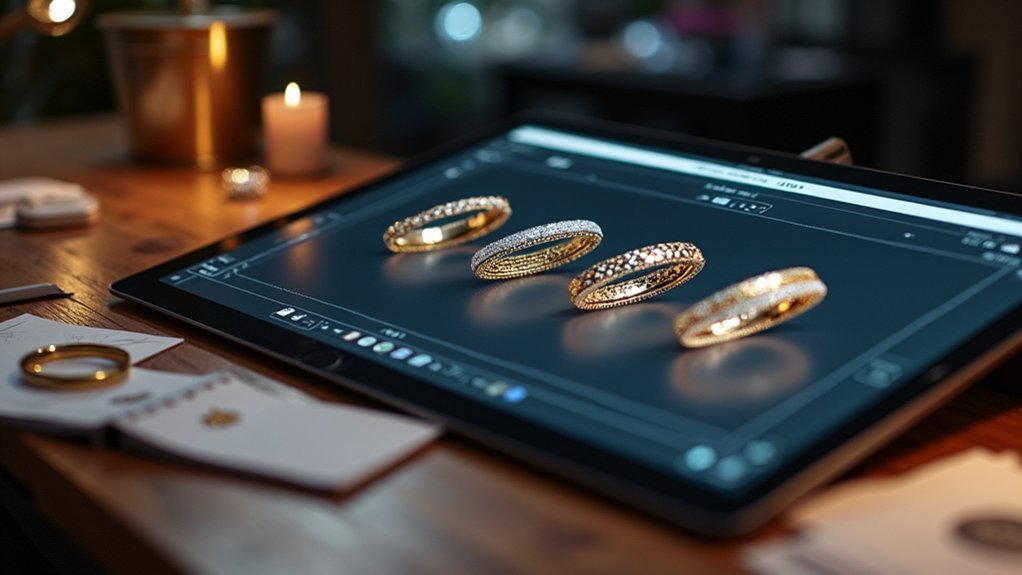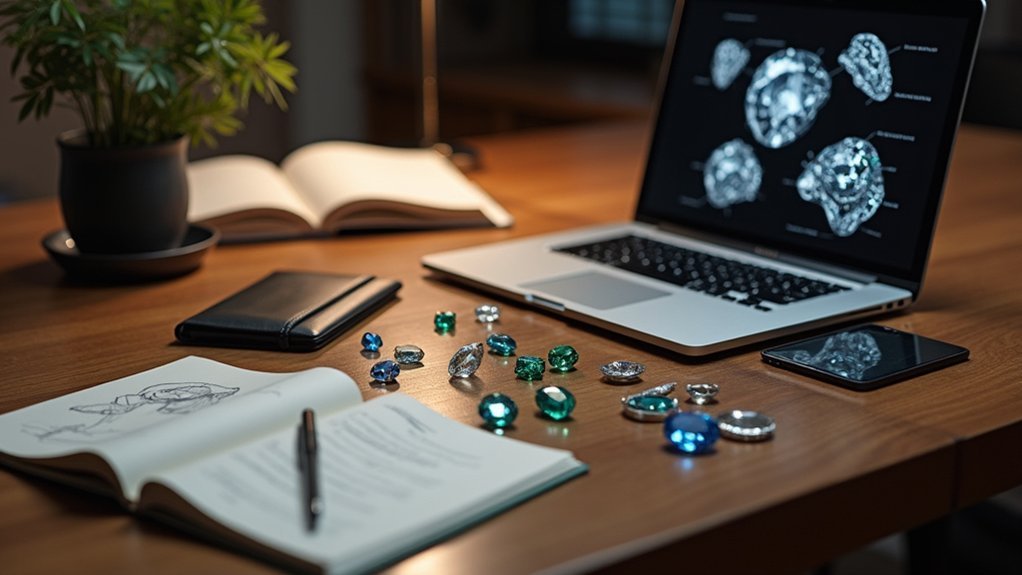You’re about to discover why most jewelry CAD consultations fail before they even begin. The difference between a designer who struggles with revisions and one who builds a thriving practice isn’t technical skill—it’s mastering client communication from that first handshake. When you can’t translate a client’s emotional vision into actionable design requirements, you’ll find yourself trapped in endless revision cycles that drain your profitability and test everyone’s patience.
Preparing for Client Initial Consultations

How can you guarantee your jewelry CAD consultation runs smoothly and sets the foundation for a successful project? Start by preparing a thorough list of client requests and preferences. Document design concepts, budget constraints, and existing gemstones they want incorporated.
Effective client communication requires visual aids like sketches and reference images to help clients articulate their vision clearly.
During initial consultations, discuss how wedding bands affect engagement ring designs to guarantee cohesive pieces. Set realistic expectations by explaining that CAD designs may appear larger than actual jewelry.
The design process demands attention to detail, so secure nonrefundable deposits and confirm essential specifications like finger size and center stone dimensions before proceeding. This preparation transforms custom design consultations into productive partnerships.
Understanding Client Vision and Design Requirements
While initial preparation lays the groundwork, translating your client’s dreams into precise design requirements demands skilled questioning and active listening. Effective client communication begins with exploring their vision through visual aids, sketches, and inspiration photos that help articulate preferences clearly.
Key elements to capture during discussions include:
- Stone preferences, including cut, color, and clarity specifications
- Metal type and finish choices that align with lifestyle needs
- Budget parameters and practical limitations affecting design scope
- Existing jewelry pieces that influence sizing and style coordination
- Future considerations like wedding band pairing and daily wear factors
Document all design specifications meticulously, ensuring transparency about budget constraints and material choices.
Address how the piece integrates with existing jewelry early in the process to achieve cohesive results that exceed expectations.
Effective Documentation and Note-Taking Strategies

Once you’ve gathered your client’s vision and requirements, effective documentation becomes the backbone of successful CAD project management.
You’ll need systematic note-taking strategies that capture every vital detail during consultations. Create organized client files using bullet-point lists for essential specifications: due dates, finger sizes, metal preferences, and design features. This clarity enhances your communication skills when briefing CAD operators and prevents costly miscommunication.
Document client feedback immediately during meetings to minimize project delays. Include visual aids like sketches and reference photos alongside written notes to create thorough documentation that aligns expectations.
Your CAD design process becomes more efficient when you regularly review and update these records throughout each project phase, ensuring evolving client requests are captured accurately and all stakeholders remain aligned.
Visual Communication Tools and Sketching Techniques
Effective documentation sets the foundation, but visual communication tools transform your client consultations from conceptual discussions into tangible design experiences. CAD software creates detailed 3D models that showcase custom pieces with unprecedented accuracy, far surpassing traditional sketches.
You’ll bridge the gap between client expectations and final products through strategic visual implementation.
Essential visual communication techniques include:
- Real-time sketching during consultations for immediate feedback and idea exploration
- Close-up photography and detailed illustrations to eliminate potential misunderstandings
- CAD mirroring techniques ensuring symmetry and precision in custom designs
- Annotated sketches facilitating direct client input throughout the design process
- 3D model walkthroughs allowing clients to visualize pieces from multiple angles
These annotated sketches create collaborative experiences, ensuring you capture every nuance of your client’s vision while maintaining professional precision.
CAD Operator Collaboration and Project Management

You’ll need to master three critical aspects when working with CAD operators to guarantee your jewelry project succeeds.
First, communicate essential project details clearly, including precise specifications and deadlines that keep everyone aligned.
Second, establish timeline expectations and pricing agreements upfront, then implement quality control standards that maintain excellence throughout the design process.
Essential Project Details
The foundation of any successful CAD project lies in thorough communication with your operator from the very start.
Clear documentation of essential project details guarantees your design services meet clients’ expectations without costly revisions or delays.
When initiating CAD communication, provide these critical details upfront:
- Timeline requirements – Specify exact due dates and any milestone deadlines for project phases
- Physical specifications – Include finger sizes, metal karat preferences, and desired color selections
- Visual references – Submit multiple photos and rough sketches showing different angles and design elements
- Stone details – Document center stone dimensions, side stone requirements, and setting preferences
- Budget parameters – Confirm pricing structure for complexity levels and request metal weight estimates
This all-encompassing approach eliminates guesswork and establishes clear project boundaries from day one.
Timeline and Pricing
Successful CAD projects hinge on establishing realistic timelines and transparent pricing agreements before work begins.
You’ll need to confirm expected readiness dates with your CAD designers while accounting for potential production delays. Complex projects require buffer time to handle unexpected issues that could derail your schedule.
Discuss pricing upfront, understanding that intricate designs and larger pieces command higher costs.
You should agree on all financial aspects before proceeding to avoid disputes later. Create bullet-point lists outlining essential details like due dates, finger sizes, and metal preferences to streamline communication.
Once designs are complete, request metal weight and gem lists from your CAD operator.
This information enables accurate cost estimation and proper budgeting for your final jewelry piece.
Quality Control Standards
When collaborating with CAD operators, maintaining rigorous quality control standards guarantees your jewelry designs meet exact specifications and professional benchmarks.
Establishing systematic protocols guarantees consistent quality throughout your project lifecycle.
- Communicate detailed project specifications including finger sizes, metal types, design preferences, and firm deadlines to align expectations with your CAD operator.
- Schedule regular design reviews to assess adherence to your specifications and make timely adjustments before issues compound.
- Create a structured feedback loop allowing immediate issue resolution between you and your operator, preventing costly delays.
- Implement version control systems tracking design iterations so everyone stays current with latest modifications and updates.
- Request thorough gem lists and metal weights upon completion for accurate cost estimations and quality verification.
Setting Realistic Expectations and Timeline Management

Before diving into the creative aspects of jewelry design, you must establish clear expectations about project timelines to prevent misunderstandings and client dissatisfaction down the road.
Successful timeline management requires transparent communication between designers and clients from the initial consultation. Present a detailed schedule that outlines each phase: design review, CAD modeling, and production. This helps clients understand when they’ll receive updates and final deliverables.
Address how design complexity affects timelines upfront. Intricate pieces require more development time, and material availability can cause delays. Discuss these potential obstacles honestly to set realistic client expectations.
Emphasize that timely feedback keeps projects on schedule, and require a nonrefundable deposit before beginning CAD work. This illustrates the commitment needed and clarifies timeline adjustment implications.
Deposit Collection and Project Approval Processes
Once you’ve established clear timeline expectations, securing a nonrefundable deposit becomes your next critical step in the CAD consultation process. This deposit collection guarantees client commitment while offsetting initial design costs.
During this phase, you’ll establish thorough project approval processes that prevent costly misunderstandings later.
Essential documentation requirements include:
- Ring specifications – finger size, metal karat, and preferred color choices
- Center stone dimensions – confirming exact carat weight and measurements
- Design sign-off protocol – written approval before production begins
- Timeline confirmation – project milestones and completion dates
- Payment structure – remaining balance and delivery terms
Effective client communication during deposit collection directly impacts design accuracy.
You’re creating a foundation where every detail is confirmed upfront, eliminating revisions and guaranteeing the final piece matches your client’s vision perfectly.
Wedding Band Compatibility and Design Considerations

When you’re designing an engagement ring, you’ll need to contemplate how it’ll pair with a future wedding band to prevent unsightly gaps between the rings.
Analyzing potential wear patterns becomes essential since rings that don’t sit flush can create pressure points that damage both pieces over time.
You should discuss these compatibility factors early in the consultation to avoid costly redesigns later.
Ring Gap Prevention
As you design an engagement ring, you’ll need to contemplate how it pairs with a future wedding band to prevent unsightly gaps and premature wear. Jewelry designers must evaluate each engagement ring’s architecture during initial consultations, guaranteeing compatibility with various wedding band styles.
Consider these visual scenarios when planning:
- A high cathedral setting creating unwanted spacing beneath the band
- Intricate side details preventing flush contact between rings
- Curved or angled shanks requiring custom-fitted wedding bands
- Prong placement interfering with band positioning
- Stone overhang causing rocking or instability
You should present CAD renderings showing both rings together, helping clients visualize the final pairing.
Remember to clarify that actual sizing and fit may differ from digital representations. Addressing compatibility early prevents costly modifications later and guarantees your clients receive perfectly matched sets.
Wear Pattern Analysis
The friction between engagement rings and wedding bands creates predictable wear patterns that you must analyze during the design phase.
You’ll identify potential design challenges by examining how different ring heights and shapes interact when worn together. Misalignment issues often emerge when the engagement ring’s profile doesn’t complement the wedding band’s curvature, leading to uncomfortable gaps or excessive rubbing.
During consultations, show clients visual examples of how various wedding band styles affect the overall aesthetic.
Straight bands require different engagement ring considerations than curved ones. You’ll prevent future problems by addressing these compatibility factors early.
Discuss how the engagement ring’s prong placement, band thickness, and stone setting height directly impact daily wear comfort and long-term durability when paired with their chosen wedding band.
Version Control and Design Revision Management
Since successful jewelry CAD consultations depend heavily on clear communication between designers and clients, implementing robust version control and design revision management becomes essential to your project’s success.
You’ll prevent confusion by maintaining organized records that track every design iteration throughout your consultation process.
Effective version control transforms your CAD workflow:
- Timestamped file naming – Use dates and revision numbers to identify the latest design instantly
- Change documentation – Record what modifications were made and why for future reference
- Client approval tracking – Mark which versions received client sign-off to avoid backtracking
- Feedback integration – Systematically incorporate client input into numbered design revisions
- Production-ready identification – Clearly label final approved versions to prevent manufacturing errors
This systematic approach enhances client communication while creating valuable references for future projects.
Building Long-Term Client Relationships Through Trust
You’ll find that authentic communication forms the foundation of every successful jewelry CAD consultation relationship.
When you’re transparent about your design process, timelines, and potential challenges, clients feel respected and informed rather than left guessing about their project’s progress.
This honest approach transforms one-time transactions into lasting partnerships where clients return for future pieces and refer others to your services.
Authentic Communication Builds Trust
When clients approach you for jewelry CAD consultations, they’re not just seeking technical expertise—they’re looking for someone who’ll genuinely understand their vision and guide them through a deeply personal process.
Authentic communication forms the foundation of trust in every consultation. You’ll strengthen client relationships by:
- Actively listening to their stories behind each piece, whether it’s an engagement ring or anniversary gift
- Speaking transparently about design possibilities, budget constraints, and realistic timelines
- Providing regular updates with visual progress shots and clear explanations of each development stage
- Addressing potential challenges honestly before they become problems, demonstrating your professional integrity
- Creating personalized interactions by remembering their style preferences and referencing previous conversations
This approach transforms simple transactions into meaningful partnerships, where clients feel genuinely valued and understood throughout their jewelry creation journey.
Transparent Design Process
Beyond establishing authentic communication, creating a transparent design process becomes your most powerful tool for building lasting client relationships.
You’ll foster trust by walking clients through each design step, explaining your artistic choices and technical constraints clearly. Regular updates during CAD development keep clients engaged and valued, preventing misunderstandings that damage relationships.
Encourage client feedback at multiple design stages to create truly personalized pieces. When you share detailed explanations of your decisions, you’re setting realistic expectations for the final product.
Visual aids like sketches and CAD renderings help clients visualize their jewelry, reinforcing confidence in your expertise. This open communication approach transforms one-time customers into loyal advocates who trust your creative vision and technical skills completely.
Frequently Asked Questions
How Much Do CAD Jewelry Designers Make?
You’ll earn $45,000-$75,000 annually as a CAD jewelry designer, with entry-level positions starting around $40,000-$50,000. If you’re freelancing, you can charge $25-$75 hourly depending on your experience and skills.
How Much Does a Jewelry CAD Cost?
You’ll typically pay $100 to $500 for jewelry CAD design, depending on complexity. Simple designs cost less, while intricate custom pieces require more time and skill, driving up the price considerably.
What Does Jewellery CAD Mean?
You’ll use jewelry CAD to create precise digital models of rings, necklaces, and other pieces. It’s computer software that lets you design, visualize, and modify jewelry before manufacturing anything physical.
How Do I Become a Jewelry CAD Designer?
You’ll need to master CAD software like Rhino or Matrix, build a strong design portfolio, gain hands-on experience through internships, and stay current with industry trends and technological advancements.
In Summary
You’ve learned that successful jewelry CAD consultations depend on your ability to communicate clearly and build trust with clients. By preparing thoroughly, documenting effectively, and using visual tools, you’ll create better design outcomes. Don’t forget to manage revisions carefully and maintain strong collaboration with your CAD team. When you focus on understanding your client’s vision and maintaining transparent communication throughout the process, you’ll establish lasting relationships that drive your business forward.





Leave a Reply